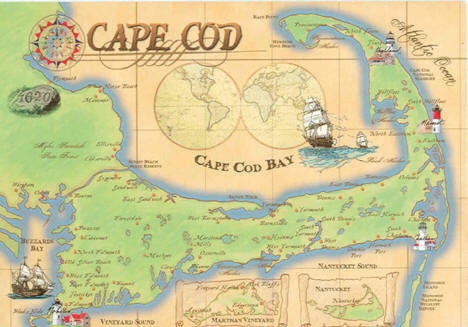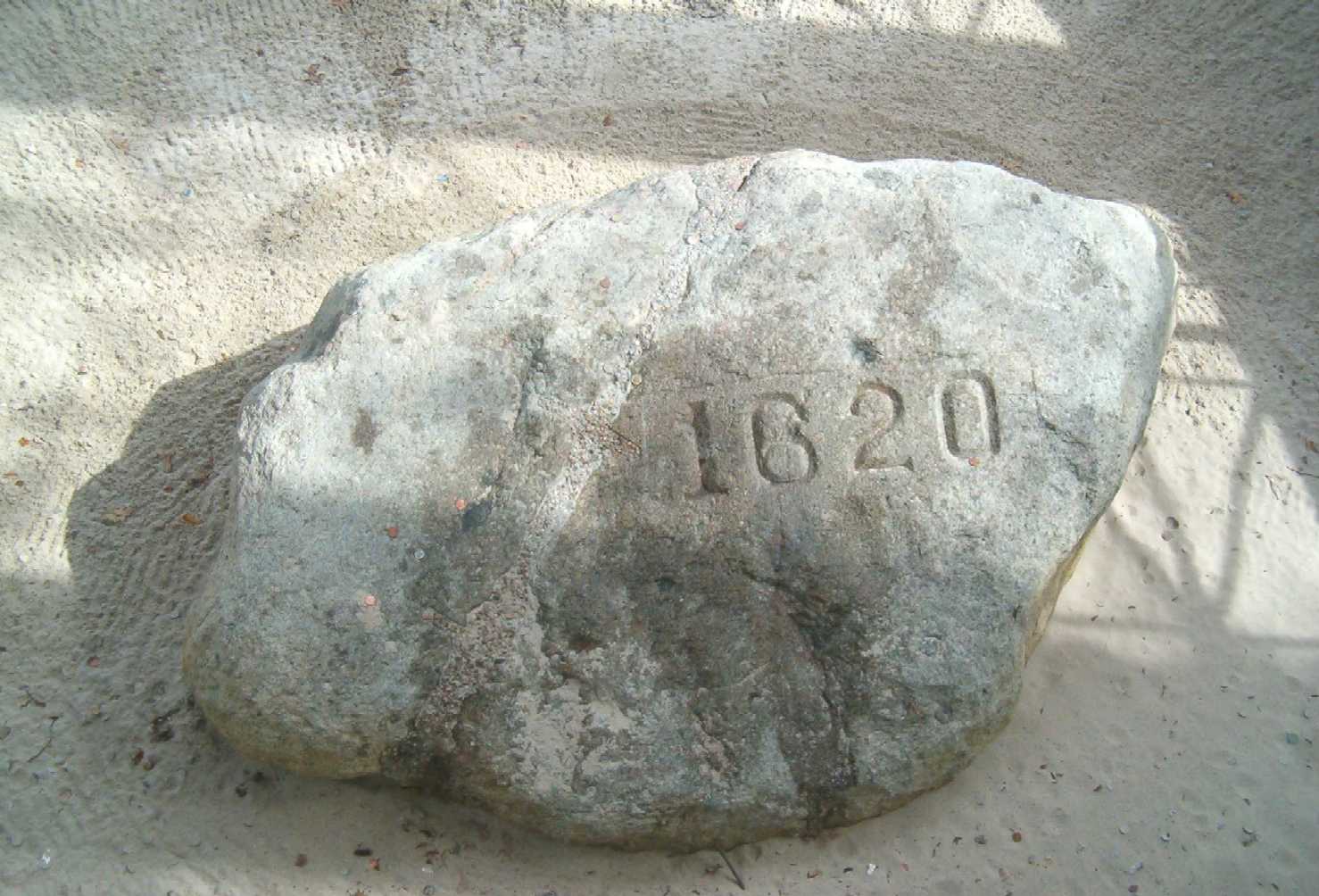
The Pilgrims didn't think much of Cape Cod. “A hideous and desolate wilderness” William Bradford called it. “Full of wild beasts and wild men.” Rather than stay, a small party from the Mayflower sailed ahead, searching for a winter haven. In December 1620, they reached Plymouth, a place “fit for situation,” Bradford wrote. “At least it was the best they could find.”
On a New England road trip a few summers ago, I washed up in Plymouth, too. It could have been Dedham or Braintree or some other pit stop on the highway near Boston. But a Red Sox game pulsed on the radio, so I drove until it ended at the Plymouth exit. Stopping for beer at Myles Standish Liquor, I was directed to the William Bradford Motor Inn, the best I could find in peak tourist season.

Early the next morning I went for a walk along the waterfront, past a chowder house, a saltwater taffy shop, a wax museum, and a replica Mayflower moored in the bay. Near the water stood a gray historic marker that was terse even by New England standards.
I looked around and couldn't see anything except asphalt and a few stones small enough for skipping. Then I spotted a lone speedwalker racing down the sidewalk. “Excuse me,” I said, chasing after him, “but where’s Plymouth Rock?”
Without breaking stride, he thrust a thumb over his shoulder. “You just passed it.”
Twenty yards back was a columned enclosure, between the sidewalk and shoreline. Stepping inside, I came to a rail overlooking a shallow pit. At the bottom sat a lump of granite, the wet sand around it strewn with cigarette butts and ticket stubs from the wax museum. The boulder, about five feet square, had a badly mended cleft in the middle. It looked like a fossilized potato.
A few minutes later a family arrived. As they entered the portico, the father intoned to his children, "This is where it all began." Then they peered over the rail.
"That's it?"
"Guess so."
"It's, like, nothing."
"We've got rocks bigger than that in our yard."

Before long, the portico was packed: tour bus groups, foreign sightseers, summer campers. Their response followed the same arc, from solemnity to shock to hilarity. But Plymouth Rock was an icon of American history. So visitors dutifully snapped pictures or pointed video cameras down at the static granite.
"That's going to be one heckuva home movie. "
"Yeah. My Visit to Plymouth Pebble."
"The Pilgrims must have had small feet."
I went over to chat with a woman in green shorts and tan shirt standing outside the enclosure, counting visitors with a hand clicker. Claire Olsen was a veteran park ranger at Plymouth, accustomed to hearing tourists abuse the sacred stone. "A lot of people come here expecting the Rock of Gibraltar," she said. "Maybe that's where they went on their last vacation."
She was also accustomed to fielding odd questions. Was it true that the Mayflower crashed into Plymouth Rock? Did the Pilgrims serve Thanksgiving on top of it? The bronze, ten-foot-tall Indian on a hill overlooking the rock -- was he life-sized?
The most common question, though, concerned the date etched into the rock's surface. Why did it say 1620, visitors wondered, rather than 1492? Wasn't that when Columbus arrived?
"Or they ask, 'Is this where the three ships landed?' " Claire said. "They mean the Niña, the Pinta, and the Santa María. People think Columbus dropped off the Pilgrims and sailed home."

Claire had to patiently explain that Columbus's landing and the Pilgrims' arrival occurred a thousand miles and 128 years apart. "Americans learn about 1492 and 1620 as kids and that's all they remember as adults," she said. "The rest of the story is blank."
As she returned to counting tourists, I returned to the Governor Bradford, chuckling over visitors' questions. America, great land of idiocy! But Claire's parting comment gave me pause. Back on the road, winding past cranberry bogs, I scanned the data stored in my own brain about America's founding by Europeans. In fourteen hundred and ninety-two, Columbus sailed the ocean blue . . . John Smith and Jamestown . . . the Mayflower Compact . . . Pilgrims in funny hats . . . Of the Indians who met the English, I of course knew Pocahontas, Squanto, and . . . Hiawatha?

That was the sum of what I dredged up. Scraps from elementary school and the Thanksgiving table. Plus some fuzzy, picture-book images of black-robed friars and armored conquistadors I couldn't identify. As for dates, I'd mislaid an entire century, the one separating Columbus's sail in 1492 from Jamestown's founding in 16-0-something. Maybe nothing happened in the period between. Still, it was distressing not to know. Expensively educated at a private school and university -- a history major, no less! -- I'd matriculated to middle age with a third grader's grasp of early America.
Returning home to Virginia, I resolved to undertake some remedial study. At first, this proved deceptively easy: most of what I wanted to know was hiding in plain sight, at my local library. After skimming a few histories, I dug deeper, reading the letters and journals of early explorers. A cinch, really -- except, an awful lot happened between Columbus and the Pilgrims. Incredible stories I'd known nothing about. This wasn't a gap in my education; it was a chasm.

By the time the first English settled, other Europeans had already reached half of the forty-eight states that today make up the continental United States. One of the earliest arrivals was Giovanni da Verrazzano, who toured the Eastern Seaboard in 1524, almost a full century before the Pilgrims arrived. Verrazzano, an Italian in command of a French ship, smelled America before he saw it: "A sweet fragrance," he wrote, wafted out to sea from the dense cedar forests of the Carolinas.
Reaching the coast, Verrazzano dispatched one of his men to swim ashore and greet some people gathered on the dunes. The natives promptly carried the Frenchman to a fire on the beach and stripped off his clothes -- not to "roast him for food," as his shipmates feared, but to warm the sailor while "looking at the whiteness of his flesh and examining him from head to toe."

Coasting north, Verrazzano was favorably impressed by a wide bay he called Santa Margarita, better known today as New York harbor. "A very agreeable place," he wrote, presciently observing that its well-populated shore "was not without some properties of value." Only at the end of his east coast cruise was Verrazzano disappointed. Natives bared their buttocks at sailors and lowered trade goods onto "rocks where the breakers were most violent." Verrazzano called this "Land of Bad People," a name since changed to Maine.
In 1528, on a return voyage to America, Verrazzano went ashore on a Caribbean island that appeared deserted. He was quickly seized by natives, then "cut into pieces and eaten down to the smallest bone." Or so claims the only surviving account of his landing, which concludes: "Such a sad death had the seeker of new lands."

History has been cruel to Verrazzano, too. In his own time, the navigator was so renowned that his name appeared on an early globe, spanning the east coast of North America. Today, he is forgotten, except as the namesake of a New York bridge that arcs over the narrows he sailed through in 1524.
Even less remembered are the Portuguese pilots who steered Spanish ships along both coasts of the continent in the sixteenth century, probing upriver to Bangor, Maine, and all the way to Oregon. En route, in 1542, one diarist wrote of California, "The country appears to be very fine," but its inhabitants "live very swinishly." That same year, Spanish conquistadors completed a reconnaissance of the continent's interior: scaling the Appalachians, rafting the Mississippi, peering down the Grand Canyon, and galloping as far inland as central Kansas (much to the surprise of the Plains Indians, who had never seen horses).

The Spanish didn't just explore: they settled, from the Rio Grande to the Atlantic. Upon founding St. Augustine, the first permanent European city on U.S. soil, the Spanish gave thanks and dined with Indians -- fifty-six years before the Pilgrim Thanksgiving at Plymouth. The Spanish also established a Jesuit mission in Virginia, a few miles from the future Jamestown. Nor were Spaniards the only Europeans on the premises. French Protestants, fleeing persecution at home, founded a Florida colony in 1564, before all but two of the Pilgrims were born.
The more I read about pre-Mayflower America, the more I wondered why I'd learned so little of it before. This wasn't a clot of esoteric names and dates I'd dozed through in high school history, like the Habsburg Succession or the War of Jenkins's Ear. This was the forgotten first chapter of my own country's founding by Europeans, a chapter mysteriously redacted from the textbooks of my youth -- and, as far as I knew, from national memory.

Anglo bias seemed the obvious culprit, but it didn't altogether explain Americans' amnesia. Jamestown preceded Plymouth by thirteen years as the first permanent English colony on the continent. Yet, like most Americans, I was ignorant of the Jamestown story, even though I'd spent much of my life in Virginia. Almost everyone knows the Mayflower, even new immigrants; the Pilgrim ship features prominently in citizenship tests. How many Americans can name the three ships that brought the first English to Jamestown? Or recall anything about the colony, except perhaps Pocahontas and John Smith?
Plymouth, it turned out, wasn't even the first English colony in New England. That distinction belonged to Fort St. George, in Popham, Maine -- a place I'd never heard of. Nor were Pilgrims the first to settle Massachusetts. In 1602, a band of English built a fort on the island of Cuttyhunk. They came, not for religious freedom, but to get rich from digging sassafras, a commodity prized in Europe as a cure for the clap.

Tony Horwitz
History isn't sport, where coming first means everything. The outposts at Popham and Cuttyhunk were quickly abandoned, as were most of the early French and Spanish settlements. Plymouth endured, the English prevailed in the contest for the continent, and Anglo-American Protestants -- New Englanders, in particular -- molded the new nation's memory. And so a creation myth arose, of Pilgrim Fathers seeding a new land with their piety and work ethic. The winners wrote the history. | May 2008
Tony Horwitz is the bestselling author of Blue Latitudes, Confederates in the Attic and Baghdad Without a Map. He is also a Pulitzer Prize–winning journalist who has worked for The Wall Street Journal and The New Yorker. He lives in Martha’s Vineyard with his wife, Geraldine Brooks, and their son, Nathaniel. A Voyage Long and Strange is his fifth book. [source: January Magazine, Copyright © 2008 Tony Horwitz]
Tony Horwitz talked about the early European explorers who arrived to the continental U.S.. He spoke on the misconceptions of most Americans in relation to the early explorers, how one can claim to "discover" a place that had active civilizations, the disjointed American history curriculum offered in most schools, and initial contacts between Europeans and natives.

No comments:
Post a Comment